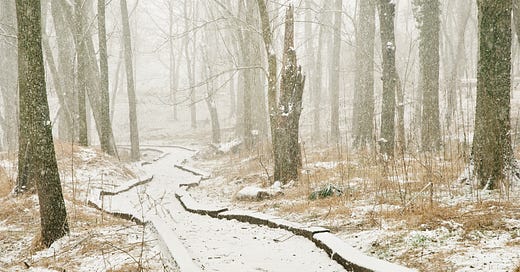Calming our minds with a walk outside
Quieting the part of our brains linked to self-criticism, sadness, and rumination
Hello, dear friends. I’m glad you are here today. The gusts are blowing hard this weekend, pummeling the sides of the rooms. I woke up in the middle of one night, in that murky chasm between sleeping and awaking, and thought there was a thunderstorm, the explosions of air smacking and reverberating across houses and rock formations along these Hudson Valley mountains.
Because of the strong wind, and the chilly temps, I haven’t made it outside much lately. But when I ran across a section of a book I’m reading, Joy of Movement by Kelly McGonigal, about “green exercise,” I started rethinking my winter hermiting. I know it’s helpful to get outside, both mentally and physically, and her illumination of why was just the nudge I needed. Perhaps is will be helpful for you, too.
Dr. McGonigal writes about studies that show that green exercise has a similar effect on our brain to meditation. One study at Stanford sent people out on a walk — one group hiked a trail by the campus, and another group strolled a busy street.
“After the scenic hike—but not the walk on the busy roadway—participants reported less anxiety and negative self-focused thinking,” she wrote. “Their post-walk brain scans revealed less activity in the subgenual cortex, an area linked to self-criticism, sadness, and rumination. Individuals who suffer from depression show more activity in this part of the brain during ‘rest’ than people who are not depressed. A walk in nature selectively silenced this part of the default state’s stream of consciousness.”
Stepping outside, beyond the busy streets, also allows our small human bodies to be in a different space. Having escaped from the stuffy confines of four walls, we are placed in the wider world, infinite on all sides, the sky stretching beyond our view. The trees, even barren, and the crips air, even the thunderous gusts, can help nudge our brain into a different realm, free our mind from the loops of worries.
Practically, how does one do this, especially on a blustery day, the kind of day when I open my door and think, Umm, no thank you!
There’s a saying, perhaps Norwegian, “There is no bad weather, only bad clothes.”
Well, barring hurricanes and blizzards, this is otherwise sound advice, I feel sheepish to admit. Here is how I bundle up:
Layers. A thin layer under your pants and under your shirt makes a whole temperature zone of difference. I like Cuddle Duds, but there are many options. Target, Kohls, Wal-Mart, Macy’s, any department store, they will all carry options for thin layers of tops and bottoms.
More layers. A turtleneck, a wool sweater, and a winter coat with zipper.
Scarf. All hail scarves!
Hat. A very warm hat, please, that has a soft, plush interior. It must cover your ears.
Gloves.
Mask. This is a pandemic revelation, but truly, a simple cotton mask makes a walk on a frigid day so much more doable. It keeps your cheeks and nose warmer, and when your face isn’t freezing, the rest of your body feels better, too.
Comfy, walkable boots. These can be the hardest winter outfit item to find. When we lived in Germany, and I realized that winter was about to become a big part of my life, I went on a hunt for everday winter boots. So many are stiff or hard to walk in or thin or uncomfortable or have heels. (Why?) I finally found a pair that are tall, waterproof, and warm, with a soft fleece lining and a rubber sole, like a sneaker. A decade old now, they are still my go-to winter boots. You may need to invest some time trying on different boots to find ones for you, but you’ll thank your past self every winter day.
Even if you don’t have a much winter attire yet, you can bundle up with what you have. Hat, gloves, and a few layers will get you far.
It can also help to think about where you will walk. If there’s somewhere nearby that inspires you — a state park, a local trail, a museum with outside walking paths — it can feel like a little treat to get out.
Dr. McGonigal notes that about the neurological change of quieting the brain’s area linked to self-criticism, sadness, and rumination has been detected during outdoor walks in nature and also in two experimental treatments for depression: transcranial magnetic stimulation and ketamine:
“… It is fascinating that the short-term neurological effect of a walk in the park—something accessible to many people—so closely resembles the mechanism for two cutting-edge treatments for depression. This may explain why the psychological benefits of being in nature are most pronounced among those who struggle with depression. It is also a reminder that making time for physical activity is not self-indulgent. For many, it is an act of self care, even self-preservation.”
Self-preservation.
Self-preservation can sound like curling up under the comforter with the glow of a screen, but it may also be opening the door to bright light, crisp air, swirling wind, and the company of trees.
I hope I get outside for a walk today, and I hope you might, too.
To our journeys,
Brianne






Thanks for sharing this too from The Joy of Movement! I really loved Kelly McGonigal’s Upside of Stress, this makes me curious to read this book, too. Also, I agree wholeheartedly about scarves- so essential in winter layering!